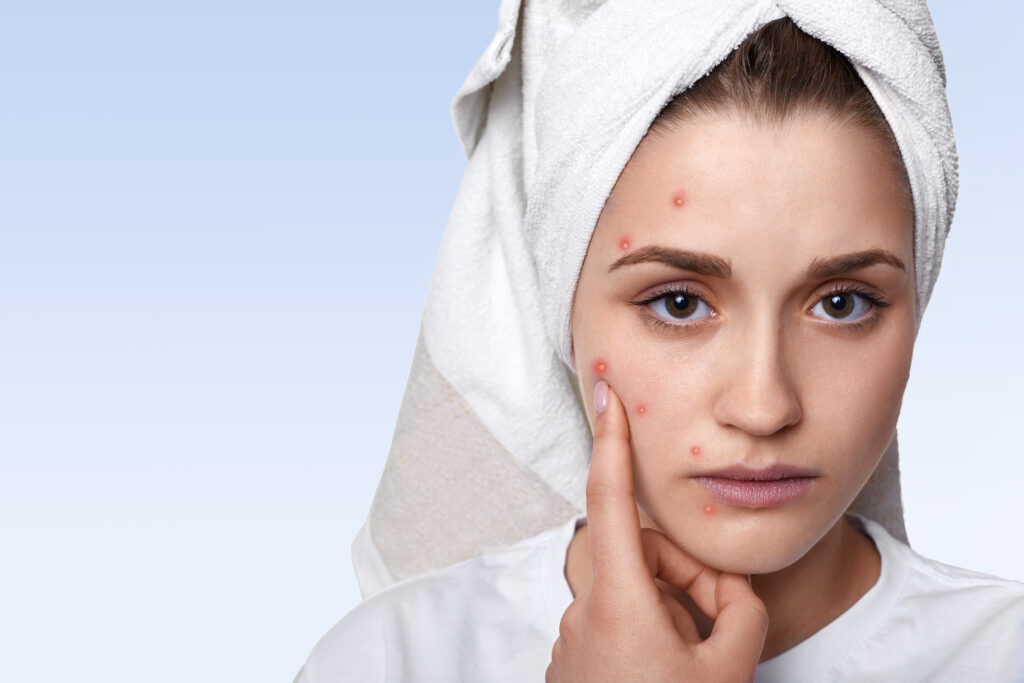Hormones are chemical messengers in the body that regulate various physiological processes, including skin function and oil production. Several hormones are particularly influential in the development of acne:
- Androgens:
- Testosterone and Dihydrotestosterone (DHT): Androgens, such as testosterone and its more potent form DHT, are key players in acne development. These hormones stimulate the sebaceous (oil) glands in the skin to produce more sebum. Excessive sebum production can clog pores, leading to acne. During puberty, both males and females experience a surge in androgen levels, which explains the increased prevalence of acne during adolescence.
- Dehydroepiandrosterone Sulfate (DHEA-S): This adrenal hormone is another androgen that rises during puberty and contributes to increased sebum production.
- Estrogens:
- Estrogens, the primary female sex hormones, generally have an anti-androgen effect, reducing sebum production and the likelihood of acne. However, fluctuations in estrogen levels, such as those occurring during the menstrual cycle, pregnancy, or perimenopause, can influence acne severity.
- Progesterone:
- Progesterone, another female sex hormone, can have varying effects on acne. In some individuals, elevated progesterone levels, such as those during the luteal phase of the menstrual cycle, can increase sebum production and exacerbate acne.
- Corticotropin-Releasing Hormone (CRH):
- CRH, released in response to stress, can stimulate the sebaceous glands to produce more oil. Stress-induced acne is a common phenomenon, highlighting the link between psychological stress and hormonal regulation of sebum production.
- Insulin and Insulin-Like Growth Factor 1 (IGF-1):
- Insulin and IGF-1, hormones involved in glucose metabolism, can influence acne development. High levels of insulin and IGF-1 can stimulate sebum production and increase the risk of acne. Diets high in refined sugars and carbohydrates can elevate insulin levels, potentially worsening acne.
Hormonal Acne: Characteristics and Triggers
Hormonal acne is typically characterized by its timing and location:
- Timing: Hormonal acne often coincides with periods of hormonal fluctuation, such as puberty, menstrual cycles, pregnancy, and menopause. It may also worsen with stress.
- Location: It commonly appears in areas with a high density of sebaceous glands, such as the lower face (chin and jawline), neck, chest, and back.
Common triggers for hormonal acne include:
- Puberty: Increased androgen levels lead to higher sebum production and a higher likelihood of clogged pores.
- Menstrual Cycle: Hormonal fluctuations throughout the menstrual cycle can trigger breakouts, particularly in the luteal phase when progesterone levels are higher.
- Pregnancy: Hormonal changes during pregnancy can lead to increased sebum production and acne.
- Polycystic Ovary Syndrome (PCOS): PCOS is a condition characterized by elevated androgen levels, leading to persistent and severe acne.
- Stress: Chronic stress can elevate CRH levels, leading to increased sebum production and acne.
Managing Hormonal Acne
Effectively managing hormonal acne often involves addressing the underlying hormonal imbalances. Treatment options include:
- Topical Treatments:
- Retinoids: These vitamin A derivatives help unclog pores and reduce inflammation.
- Benzoyl Peroxide: This antimicrobial agent can help reduce acne-causing bacteria.
- Salicylic Acid: This beta-hydroxy acid exfoliates the skin and helps unclog pores.
- Oral Medications:
- Oral Contraceptives: Birth control pills containing estrogen and progestin can help regulate hormonal fluctuations and reduce androgen levels.
- Anti-Androgens: Medications like spironolactone can block androgen receptors, reducing sebum production.
- Isotretinoin: This powerful retinoid is reserved for severe acne cases and works by significantly reducing sebum production.
- Lifestyle Modifications:
- Diet: Reducing intake of high-glycemic foods and dairy products may help manage insulin and IGF-1 levels, reducing acne severity.
- Stress Management: Techniques such as meditation, yoga, and regular exercise can help reduce stress-induced acne.
Conclusion
Hormones play a critical role in the development and severity of acne. Understanding the hormonal mechanisms behind acne can help in devising effective treatment strategies, from topical treatments to lifestyle modifications. By addressing the hormonal imbalances that contribute to acne, individuals can achieve clearer, healthier skin and improve their overall quality of life.
